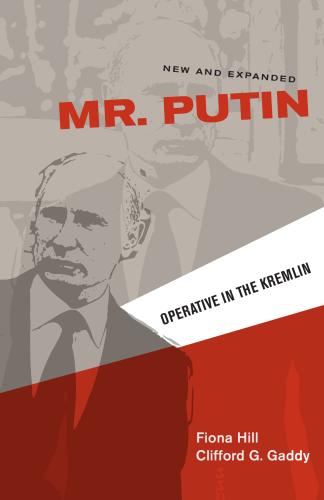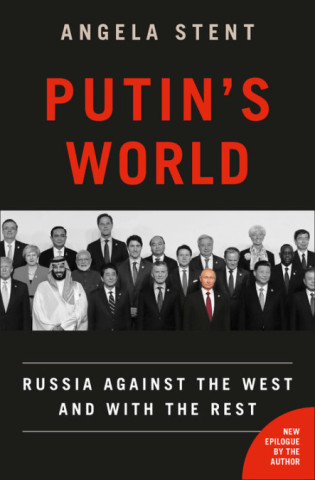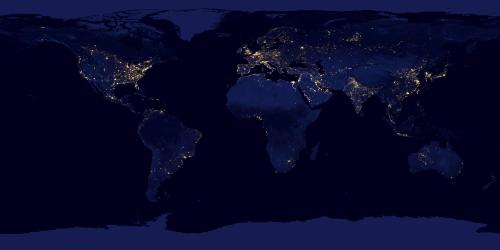Great power competition is back, write Alina Polyakova and Torrey Taussig. Russia and China—two great powers with autocrats at their helms—are actively testing the durability of the international order as the West seemingly retreats. There seem to be no effective checks to Putin and Xi’s growing ambitions. Both leaders, however, could be making a strategic error. This piece originally appeared in Foreign Affairs.
Great power competition is back. Russia and China—two great powers with autocrats at their helms—are actively testing the durability of the international order as the West seemingly retreats. Russian President Vladimir Putin, unfazed by Western sanctions, not only led a disinformation campaign in Western democracies to disrupt major elections, but continues to maintain Russia’s occupation of Crimea and the Donbas region in eastern Ukraine. Chinese President Xi Jinping, meanwhile, is projecting China’s military power into the South China Sea and its economic might across Latin America, Africa, and Asia. Both countries also seek to influence democratic states through the use of “sharp power.” Aware of Russia and China’s growing reach, the Trump administration made the right decision to identify the two nations as U.S. competitors in its recently released National Security Strategy and National Defense Strategy. For the first time since September 11, 2001, great power competition, rather than global terrorism, is considered the number one priority for U.S. national security.
There seem to be no effective checks to Putin and Xi’s growing ambitions. Both leaders, however, could be making a strategic error. They are staking their countries’ futures, and international trajectories, on one thing: themselves. Throughout their respective reigns, Putin and Xi have taken steps to consolidate their personal control on power. This may work as a stabilizing mechanism in the short term, but in the long term, can exacerbate inherent domestic tensions that could eventually undermine their rule. Putin and Xi face two similar dilemmas as long-time autocrats of large countries: managing brutal elite competition for loyalty and succession, and balancing international ambitions with deepening tensions between the central government and restive regions. As both leaders seek more “wins” to justify their personal control at home, they may increasingly pursue riskier and bolder foreign policies.
As the United States weighs its approach to this new era of great power politics, U.S. policymakers will need to take into account how the internal domestic tensions inherent to personalist systems will affect Putin and Xi’s foreign policy agendas.
THE KNIVES ARE OUT
Autocrats have to be good managers. A strongman’s position is only as secure as his network of elite loyalists. But political loyalties, even in authoritarian regimes, are fickle. It is quite certain that Putin will win reelection in March. Thus, the real competition lies in the internal jockeying among the Kremlin elite—once hidden, these internal battles are increasingly being played out in public view. Even Putin’s allies, such as Igor Sechin, the head of Rosneft, are taking political risks to push out potential competitors. In November 2016, Sechin carried out a sting operation that took down former Russian Economy Minister Aleksei Ulyukayev by exposing his involvement in a bribery scheme. There are also signs that Putin’s grip on the elite, and on Sechin in particular, is loosening. Putin reportedly asked Sechin to testify in the Ulyukaev case, but Sechin refused, dealing a public blow to the Russian leader.
As Moscow’s palace games intensify in the lead up to the March election, Putin will need to prove to an anxious and wavering elite that he is still the people’s chosen leader. To reaffirm his mandate, Putin is reportedly seeking to achieve a 70/70 goal: to win the election with a 70 percent turnout and with 70 percent of the vote. At the very least, Putin will need to surpass his 2012 results (65 percent turnout with 64 percent of the vote). In this regard, it is most likely not a coincidence that the presidential elections are being held on the anniversary of Russia’s annexation of Crimea, a foreign policy gamble that increased Putin’s popularity ratings by 21 percentage points, his largest boost to date. In contrast, Russia’s intervention in Syria produced only a five percent bump for Putin, from 83 to 88 percent. Beyond the elections, Putin will have to reenergize his support base by shoring up nationalist-populist sentiments—so far, foreign incursions have been the only winning formula to achieve that goal.
Unlike in Putin’s Russia, elite competition in China is contained within the institutionalized one-party system. Yet Xi’s rapid consolidation of control is testing the bounds of China’s collective leadership model. Xi is considered the most powerful ruler in China since Mao Zedong. Xi’s accumulation of official titles (he currently holds thirteen) culminated in the decision at the 19th Party Congress to enshrine “Xi Jinping Thought” in the nation’s constitution. Moreover, Xi’s stringent anti-corruption campaign, known as “killing tigers and swatting flies,” is testing the loyalty of the elite. Although Xi came into office with a mandate to clean up the party ranks, Xi’s weeding out of high- and low-level cadres has left many in the Party unsure of where Xi’s favor lies—and unwilling to test it. Prominent cases involving the “tigers” include Xu Caihou and Guo Boxiong, both former vice chairs of the Central Military Commission, who were both found guilty of extraordinary corruption. Their falls from grace serve as reminders that no position in the party is safe—a sentiment that may leave Xi with more enemies than loyalists.
This new reality in China indicates that if Xi shows support for a policy shift—whether aggressive or cautious—his decision is unlikely to meet significant pushback from the upper echelons of the Chinese leadership. This can give Chinese leaders a false sense of confidence in their national capabilities and result in “groupthink” among Xi’s advisers. History reveals, however, that foreign policy strategies devised under both criteria often end with disastrous results.
CENTER-PERIPHERY TENSIONS
Large countries ruled by authoritarian figures who centralize control inevitably face internal tensions between the center and the periphery. As with its political structures, Russia’s management of its finances is highly centralized: resources such as oil production revenues and taxes flow from the resource-rich regions to Moscow for redistribution to the resource-poor provinces. While the economy was booming in the early 2000s due to high oil prices, the Kremlin could maintain the delicate dance of keeping the peace among Russia’s 85 provinces. But as oil prices collapsed in 2015 and as they remain stubbornly low, Russia’s hydrocarbon-dependent state budget has suffered. Western sanctions have also begun to take a toll, contributing 1.5 percent to Russia’s decline in GDP in 2015.
As the state coffers shrunk along with the overall economy, Moscow took a larger cut of revenues from the provinces, which are now starting to openly rebel. Resentment is growing in the oil-rich Sakhalin region, where Moscow has laid claim to increasingly larger shares of the oil revenues. Last fall, Moscow passed new federal legislation seeking to siphon 75 percent of tax and royalties from the profitable Sakhalin-2 project. Under current law, Moscow receives a 25 percent cut. Governors and local populations, already living on meager incomes, are openly airing their grievances through protests. At the same time, regions facing a budget shortfall complain that they are not getting enough from Moscow to maintain basic services and infrastructure. Across Russia, regional governments are demanding more autonomy and more control over their budgets. The Kremlin’s ability to calm the waters or to repress dissent is constrained by its continued need for more money and its limited reach outside of Moscow and St. Petersburg. Without economic growth in sight, Putin will face a Catch-22: increased resentment in the provinces coupled with a constant need to shore up popular support through costly operations abroad.
As Putin and Xi deal with internal tensions among their elites and their broader populations, their foreign policy strategies will become increasingly difficult to contend with.
Xi Jinping is also having to deal with center-periphery tensions, all the while presiding over the rise of ardent nationalism and patriotism across China. Xi’s three-hour speech at the 19th Party Congress in October was full of nationalist sentiment. He reaffirmed his promise to usher in a “great rejuvenation of the Chinese nation” and vowed to restore the country to its rightful place in the world. Taking a more strident tone, Xi boasted of China’s South China Sea island reclamation project as one of his greatest achievements. But Xi’s ambitious plans for China, internally and internationally, come at a cost. Xi is having to expend significant resources to crack down on China’s more restive populations, including in Hong Kong and Xinjiang. These efforts are meant to ensure domestic stability and regime security and to warn all Chinese citizens to stand behind Xi’s “Chinese Dream.”
In November 2017, China’s National People’s Congress demanded that the semi-autonomous Hong Kong adopt its “National Anthem Law,” which makes insulting or disrespecting the national anthem illegal and punishable by jail time. This may have been a response to defiant protesters in Hong Kong who have taken to booing the Chinese anthem at soccer matches in recent years. Once a model of what a prosperous and open China could look like, Hong Kong’s ability to withstand China’s encroaching authoritarian system is fading. In the northwestern province of Xinjiang, Xi has carried out draconian and repressive police surveillance over the minority Uighur population. While Beijing claims that these measures are to address terrorist threats, the tensions are also about rising resentment among the local population toward the central government.
Internal dissent puts the Communist Party of China in a difficult position. On the one hand, Xi is aiming to increase his domestic legitimacy through nationalistic appeals, while on the other hand, he is seeking to reassure China’s wary neighbors that his nation wants peace and cooperation. Looking ahead, if Xi finds that quelling domestic instability through national propaganda at home and shows of strength on core interests like the South China Sea is more important than assuaging regional actors, then stability will likely suffer.
STABLE UNTIL THEY’RE NOT
As Putin and Xi deal with internal tensions among their elites and their broader populations, their foreign policy strategies will become increasingly difficult to contend with. The United States will need to strike a balance against a more assertive China and a volatile Russia as it pursues its own national security interests. Although the challenges that Putin and Xi present will engage the United States for years to come, in the immediate term, the Trump administration should take specific steps to manage these two competitor states.
Putin’s intervention in Ukraine and Syria seemingly caught the Obama administration by surprise, and as result, the response was slow and cautious. Future Russian interventionism will require a quick and decisive response. While it is impossible to know exactly where Putin may next seize the opportunity to launch a conventional or nonconventional strike, the Trump administration should prepare responses for a range of possible aggression, whether it’s a hybrid war against states on Russia’s periphery or continued disinformation campaigns in the West.
Xi’s global ambitions, however, present the greatest long-term challenge to the United States. China has time on its side; its military and economic capabilities are growing relative to the United States’. The Trump administration should thus leverage its current advantages now. This means investing in long-established partnerships and building new relationships with states in the Indo-Pacific region to diminish incentives for aggression on China’s part.
In the end, Putin and Xi’s consolidation of control will leave them personally responsible for their governments’ successes and missteps. The buck stops with them. In turn, Putin and Xi will likely respond to growing economic and political pressures by seeking more control at home while taking greater risks abroad. Domestically, this will mean harsher measures to silence the voices of the opposition, to neuter political competition, and to restrict access to information. But repression is a costly way to ensure long-term compliance from a citizenry. Putin and Xi might find it easier to enhance legitimacy by depicting their regimes as “defenders of the people” against malevolent outsiders and thus might feel the need to pursue aggressive tactics abroad, even though these impulses will ultimately only deepen the cracks in each regime. Putin and Xi may look like the world’s most powerful strongmen, but the age-old axiom still applies: authoritarian regimes are stable, until they are not.









Commentary
The autocrat’s Achilles’ heel
February 5, 2018